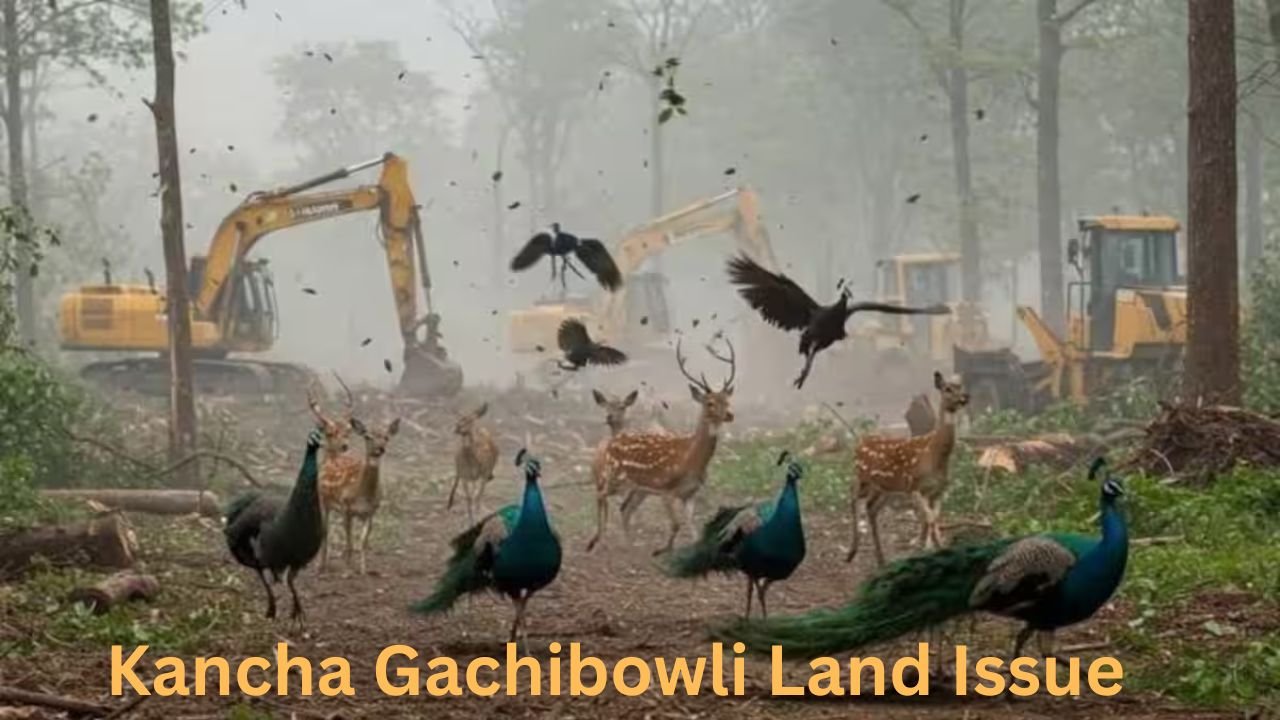Kancha Gachibowli Land Issue: Hyderabad, a city that seamlessly blends heritage and innovation, is now at the heart of a brewing storm. The Kancha Gachibowli land issue has ignited a wave of unrest, not just among students and environmental activists, but also across the broader citizenry. As bulldozers rolled in to flatten a lush urban forest, the question on everyone’s mind was simple: What price are we willing to pay for development?
Kancha Gachibowli Land Issue
This blog will walk you through every detail of the Kancha Gachibowli land issue, from its ecological significance to the legal complexities, and the fiery protests that have gripped the city.
The Origin: A Forest in the Middle of a Metropolis
Nestled adjacent to the University of Hyderabad (UoH), the Kancha Gachibowli forest is more than just a green patch—it’s a thriving ecosystem in an otherwise concrete landscape. Covering around 400 acres, it is one of the last remaining urban forests in the city, housing a diverse range of flora and fauna.
But in February 2025, the Telangana government dropped a bombshell. They announced plans to auction this land for the development of IT parks—an ambitious project expected to rake in investments worth ₹50,000 crore and generate up to 5 lakh jobs. The forest was suddenly transformed from a quiet retreat into prime real estate gold.
The Government’s Justification: Economic Growth vs Ecological Loss
The Telangana government’s rationale is clear: the land lies at the heart of Hyderabad’s booming Financial District. Development here is seen as a golden opportunity to bolster economic growth, create jobs, and expand the IT corridor.
According to the Telangana Industrial Infrastructure Corporation (TGIIC), the auction layout was designed to preserve iconic natural formations like the ‘Mushroom Rock’ and maintain green zones. They argue that the development would be “eco-sensitive” and well-planned.
However, critics say otherwise. Activists argue that replacing dense green cover with corporate towers can never be truly “eco-sensitive.” And this forms the crux of the Kancha Gachibowli land issue—a battle between rapid urbanisation and environmental preservation.

Who Owns the Land? The Legal Tangle
The ownership of the land has always been murky. The 400 acres in question were part of a 2,300-acre parcel originally allotted to the University of Hyderabad in 1974. Over the years, chunks of it were reallocated for public infrastructure and facilities—bus depots, stadiums, and more.
Interestingly, in 2003, the land was handed over to a private sports firm. But after no development took place, it was reclaimed in 2006. Since then, its status has remained contentious. The Supreme Court had earlier confirmed that the Telangana government holds legal ownership, yet the land was never officially demarcated nor notified as forestland.
But here’s where it gets tricky.
The landmark Supreme Court judgment in T N Godavarman Thirumulpad v Union of India (1996) laid down that any land with forest characteristics qualifies as forest land—even if it is not officially notified. This forms the legal backbone of current protests, and puts the Telangana government on thin ice.
Student-Led Resistance: The Forest Becomes a Symbol
When over 50 bulldozers entered the UoH east campus on March 30, 2025, it wasn’t just soil they were digging—it was the conscience of a generation.
Students immediately launched protests, forming human chains and chanting slogans to “Save Kancha Gachibowli.” Their resistance quickly turned into an indefinite strike. Police clamped down, detaining 53 students and arresting two, while many others suffered injuries.
This heavy-handed response only galvanized public support. Videos and photos of peaceful students facing riot police went viral, sparking outrage on social media. Suddenly, the Kancha Gachibowli land issue wasn’t just a campus concern—it had national attention.
Environmental Concerns: A City’s Lungs Under Threat
Environmentalists have long warned about the ecological impact of losing urban forests. Kancha Gachibowli acts as a crucial carbon sink, cooling the surrounding area, filtering pollutants, and hosting endangered species including those protected under Schedule-I of the Wildlife Act.
Organizations like Save City Forest emphasized that clearing forest land without an Environmental Impact Assessment (EIA) and wildlife clearance is a direct violation of environmental laws. Some groups are even calling for the area to be declared a National Park—a status that would permanently safeguard the land from future encroachments.
If the government could preserve KBR Park in the 1990s—another green space surrounded by upscale neighbourhoods—why can’t they do the same here?
Judiciary Steps In: Supreme Court’s Suo Motu Action
Amid growing tension, legal avenues were swiftly activated. Two Public Interest Litigations (PILs) were filed in the Telangana High Court. The court responded by issuing an interim order halting the tree felling until further review.
However, the real twist came on April 3, when the Supreme Court took suo motu cognisance of the matter.
Calling the deforestation activities “alarming,” the apex court ordered the state government to immediately stop all work and justify its urgency. A central empowered committee has now been assigned to inspect the site and submit a report by April 16. The High Court, meanwhile, has pushed the next hearing to April 7.
In one stroke, the Kancha Gachibowli land issue became a national-level legal and environmental flashpoint.

Political Reactions: A Balancing Act
Facing growing backlash, Telangana Chief Minister A Revanth Reddy announced the formation of a ministerial committee to mediate the crisis. Comprising senior ministers Mallu Bhatti Vikramarka, D Sridhar Babu, and Ponguleti Srinivas Reddy, the committee is tasked with speaking to all stakeholders—students, university officials, environmental groups, and civil society.
While the move appears conciliatory, activists remain skeptical. They want legal safeguards, not temporary reprieves.
The ministerial group’s recommendations are expected to shape the future of the Kancha Gachibowli land issue—but whether it will favour development or conservation remains to be seen.
The Bigger Picture: Urban Forests and India’s Future
The Kancha Gachibowli episode is not an isolated incident. Across India, urban forests are increasingly under threat from infrastructure and real estate projects. As cities grow, the value of such lands rises, often outpacing their ecological significance in the eyes of policymakers.
Yet, with rising temperatures, worsening air quality, and increased flooding, the importance of urban green spaces has never been greater. The Kancha Gachibowli land issue serves as a wake-up call: our cities must grow, but not at the cost of environmental collapse.
What Lies Ahead for Kancha Gachibowli?
With legal proceedings underway and public sentiment boiling over, the future of Kancha Gachibowli hangs in the balance. The forest has become more than just a piece of land—it’s a symbol of resistance, a litmus test for democratic planning, and a battleground between progress and preservation.
Whether the government retracts its decision or pushes forward with modified plans, the Kancha Gachibowli land issue has already left a deep imprint on Hyderabad’s collective conscience. It has reminded everyone—citizens, students, and leaders alike—that development, when done without dialogue or ecological foresight, will always come at a cost.










